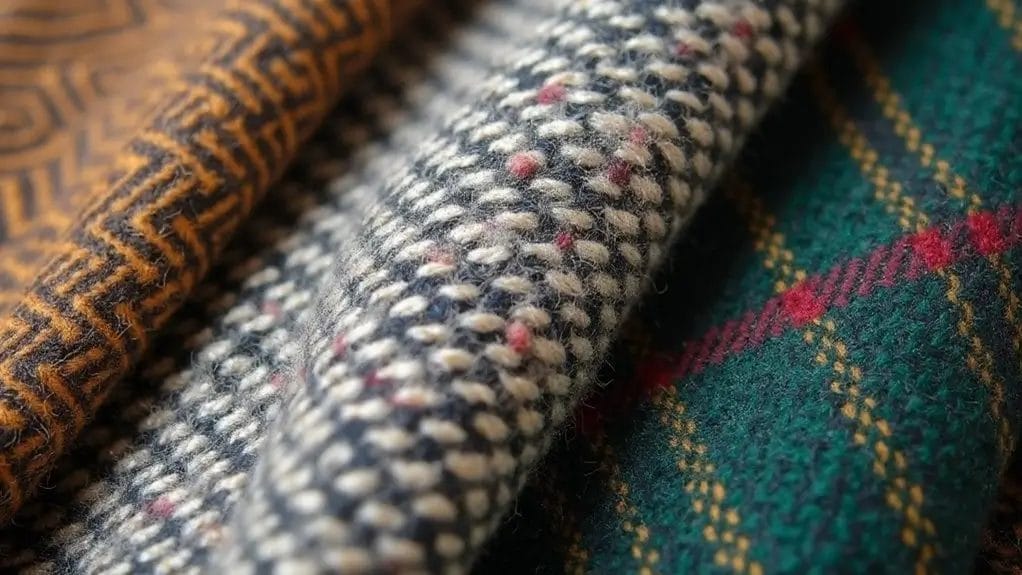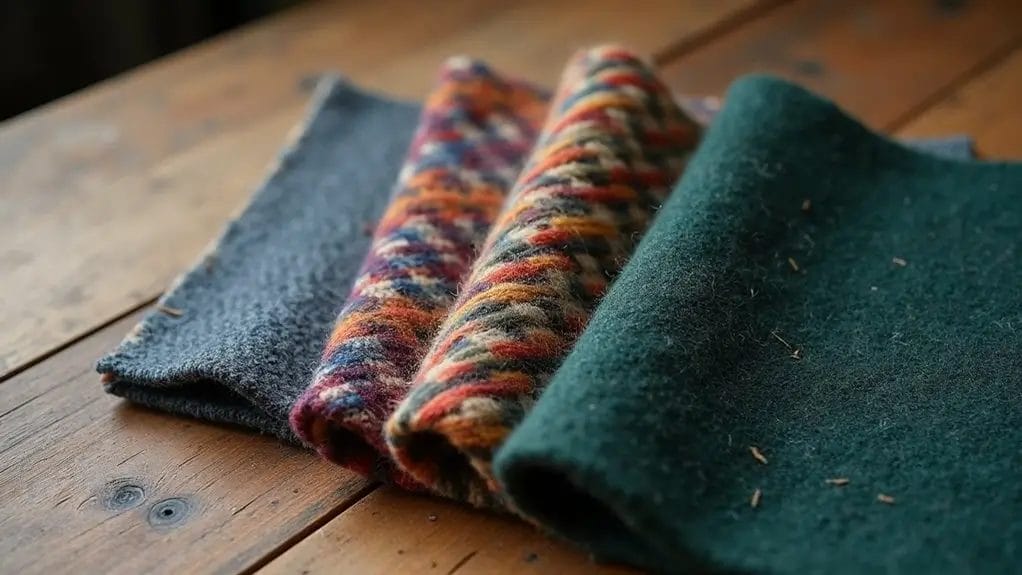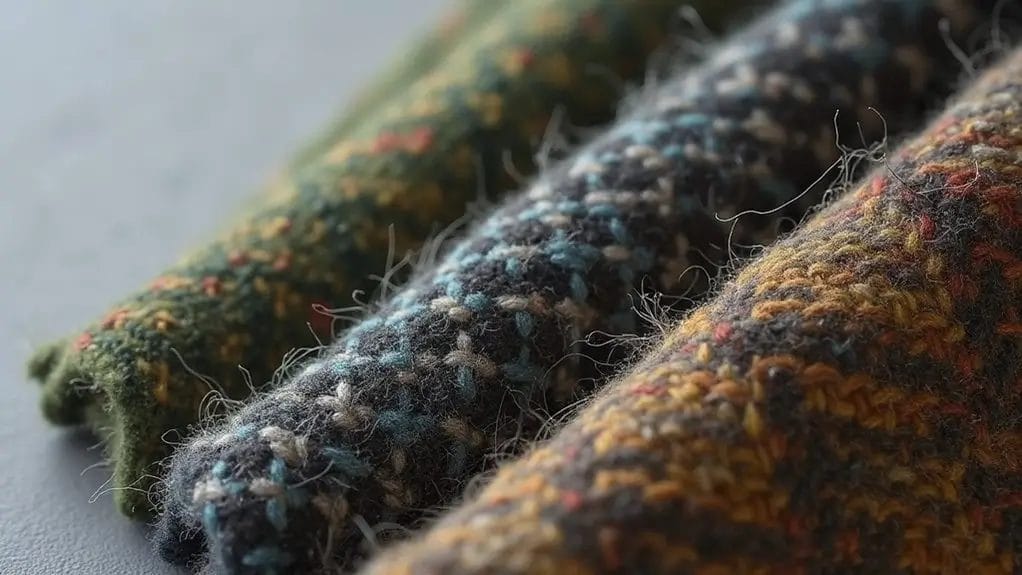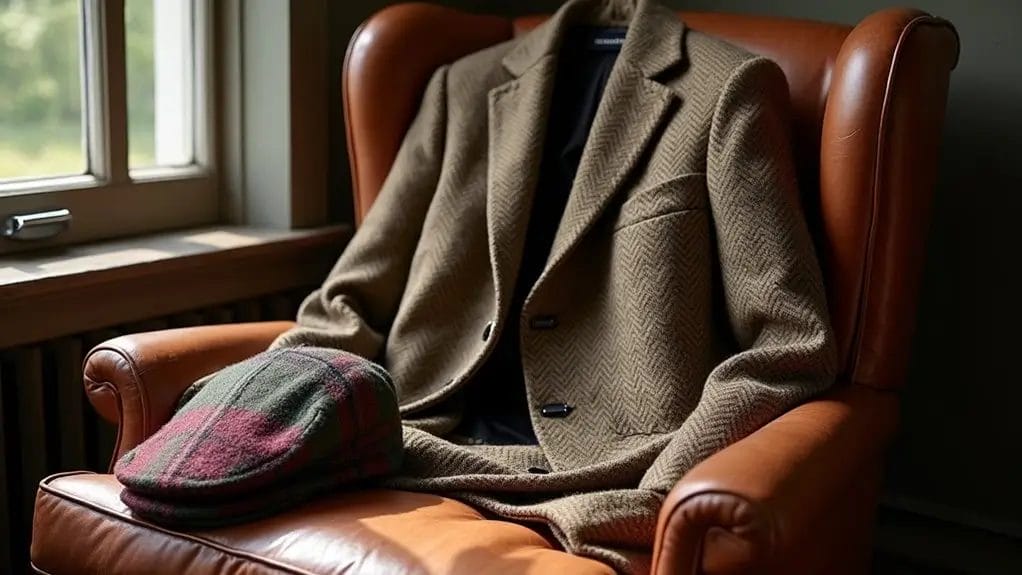You'll find that tweed's journey from Scottish highlands to modern runways tells a fascinating story of textile innovation. This durable wool fabric, first woven in the 18th century, has evolved from practical countryside attire to a symbol of refined sophistication. Each distinctive pattern and weave technique, from Harris to Donegal, carries its own heritage and purpose. As you explore tweed's varied landscape, you'll discover why this versatile fabric continues to captivate designers and fashion enthusiasts alike.
Key Takeaways
- Harris tweed stands as a protected heritage fabric, handwoven in Scotland's Outer Hebrides under strict regulations since 1993.
- Donegal tweed features distinctive multicolored flecks throughout the fabric, protected by European Geographical Indication for authenticity.
- Herringbone tweed displays a characteristic V-shaped pattern, creating a timeless look popular in modern fashion.
- Shetland tweed offers a lighter weight option while maintaining traditional texture, making it suitable for contemporary casual wear.
- Saxony tweed utilizes fine Merino wool to create a luxuriously smooth finish, perfect for elegant draping and formal attire.
What is Tweed?

Tweed, a rugged woolen fabric originating in Scotland during the 18th century, consists of a distinctive twill or herringbone weave pattern made from dyed wool fibers.
You'll find this textile's unique characteristics stem from its manufacturing process, where multiple colored yarns are woven together to create complex patterns and textures. The wool yarn undergoes a specific spinning technique that creates its signature flecked appearance.
Originally designed for durability and weather resistance, tweed fabric has evolved from practical countryside wear to a symbol of sophistication.
The weave structure allows for various patterns, including the famous Harris Tweed, which must be handwoven by islanders in Scotland's Outer Hebrides.
Types of Tweed Fabric

The rich heritage of tweed encompasses several distinct varieties, including the V-shaped pattern of Herringbone, the colorful flecked Donegal from Ireland, and the world-renowned Harris Tweed from Scotland's Outer Hebrides.
You'll find Shetland Tweed crafted from the soft wool of Shetland sheep, characterized by its lighter weight and traditional Fair Isle patterns.
Saxony Tweed, developed in Germany during the 19th century, features a softer finish due to its use of merino wool and represents one of the fabric's more refined variations.
Herringbone Tweed
Characterized by its distinctive V-shaped pattern, herringbone tweed emerged in Ireland and Scotland during the 1800s, deriving its name from its resemblance to a herring fish's skeleton.
This iconic wool tweed fabric features a broken twill weave, creating its signature zigzag texture.
- You'll notice the pattern's created by weaving colored and undyed yarns in opposing directions.
- You can identify authentic herringbone by its symmetrical V-shaped columns.
- You'll find it's woven using a 2:2 twill structure, creating durability and depth.
- You can spot traditional herringbone in neutral tones, though modern versions embrace bold colors.
Donegal Tweed
While herringbone showcases geometric precision, Donegal tweed captures Ireland's rugged landscape through its distinctive flecked appearance.
Originating in County Donegal during the 1800s, this fabric features small, colorful nubs of dyed wool woven into a robust textile base.
You'll recognize authentic Donegal tweed by its characteristic speckled pattern, created when weavers blend contrasting colors of wool into the yarn before weaving.
Today, you'll find this durable fabric protected under European Geographical Indication, ensuring that genuine Donegal tweed comes exclusively from its namesake region in Ireland.
Harris Tweed
Among Britain's most prestigious textiles, Harris Tweed stands as a protected heritage fabric handwoven by islanders in Scotland's Outer Hebrides.
This iconic Scottish wool fabric's manufacturing process follows strict regulations protected by the Harris Tweed Act of 1993.
- Every authentic Harris Tweed product carries the Orb Mark certification, proving it's genuinely made in the Hebrides.
- Skilled artisans dye pure virgin wool before spinning and weaving it on traditional looms.
- You'll find this durable fabric in classic menswear, upholstery, and luxury accessories.
- The unique flecked appearance comes from blending differently colored wool fibers before spinning.
The fabric's weather-resistant properties and exceptional durability have made it a favorite among outdoor enthusiasts and fashion designers alike.
Shetland Tweed
Shetland Tweed originates from Scotland's northernmost Shetland Islands, where local weavers have crafted this lightweight wool fabric since the 1800s using fleece from native Shetland sheep.
You'll find this lightweight tweed features a distinctive loose weave that's less structured than other varieties.
While traditionally coarse due to the Shetland sheep's natural fibers, modern producers often blend the wool with merino wool for enhanced softness.
The fabric's characteristic texture comes from combining different colored yarns in the weaving process, creating subtle, heathered effects.
Today's Shetland Tweed maintains its historical roots while adapting to contemporary fashion demands through innovative blending techniques.
Saxony Tweed
Moving from the rugged Scottish isles to the refined mills of England, Saxony Tweed represents a distinctly luxurious variety in the tweed family. This exceptional fabric emerged in the 19th century when English weavers combined fine Merino wool with traditional tweed techniques.
- You'll find Saxony cloth features tightly twisted yarns made from the finest Saxony sheep fiber.
- The fabric's distinctive smooth finish sets it apart from rougher tweed varieties.
- You're getting superior draping qualities ideal for tailored garments and formal wear.
- The cloth's refined texture revolutionized tweed's reputation from rustic to sophisticated.
This premium tweed variation remains a hallmark of superior British textile craftsmanship.
Cheviot Tweed
Named after the hardy Cheviot sheep native to the border hills between England and Scotland, Cheviot tweed emerged in the late 18th century as a robust and versatile cloth.
This type of tweed features a coarser, sturdier weave than other varieties, making it ideal for countryside pursuits and outdoor wear.
You'll find Cheviot tweed particularly resistant to moisture and wear, thanks to its unique fiber structure.
The kind of fabric produced from Cheviot wool creates a timeless tweed jacket that's both practical and stylish.
Its distinctive rough texture and exceptional durability have made it a favorite among those seeking traditional British outerwear that withstands the test of time.
Characteristics of Tweed

Tweed's distinct characteristics emerge from its complex texture and substantial weight, which you'll find ranges from medium to heavy depending on the wool yarn's thickness and weaving pattern.
You'll notice tweed's remarkable durability stems from its tight weave and robust wool fibers, traditionally engineered to withstand harsh Highland weather conditions since the 18th century.
The fabric's signature appearance includes characteristic patterns such as herringbone, check, and houndstooth, while its colors often reflect the natural landscape dyes historically used in Scotland, including browns, greens, and heathers.
Texture and Weight
Although tweed fabrics vary considerably in their specifications, the textile's characteristic rough texture and substantial weight remain defining features across all varieties.
You'll find this fabric of choice exhibits distinctive qualities that set it apart from lighter alternatives like cotton, merino, or cashmere.
- Traditional tweeds typically weigh 12-18 ounces per yard, making them ideal for outerwear.
- The texture ranges from coarse and robust to moderately smooth, depending on fiber composition.
- Surface characteristics include visible diagonal ribs, flecks, and raised weave patterns.
- Modern tweed blends maintain the classic weight while offering improved softness through fiber innovation.
Durability and Longevity
When properly maintained, tweed fabric stands as one of the most enduring textile choices available, with garments routinely lasting decades of regular wear. The durability of tweed stems from its tightly woven wool fibers, which create natural resistance to wear, moisture, and environmental stress.
You'll find that a well-crafted tweed suit remains a staple in many wardrobes since the 1800s and is still used extensively today.
The fabric's versatile nature allows it to maintain its shape and appearance through regular use. The tight weave pattern, combined with wool's natural elasticity, guarantees your tweed pieces will retain their structural integrity far longer than most other textiles.
Patterns and Colors
The traditional patterns of tweed fabric encompass four primary variations: herringbone, checks, plain twill, and overcheck.
You'll find these iconic designs woven into the fabric's rich heritage, each pattern offering distinct visual appeal and versatility.
- Herringbone features a distinctive V-shaped weave, often incorporating houndstooth variations.
- Check patterns range from subtle district checks to bold windowpane designs.
- Plain twill displays diagonal ribs with a multicolored palette, creating depth.
- Overcheck combines a base pattern with striped overlays, historically used to identify Scottish clans.
These patterns traditionally use earth tones, heathers, and moorland colors, reflecting tweed's origins in the Scottish Highlands.
Styling Tweed in Modern Fashion

Today's versatile tweed styling extends far beyond its traditional Highland roots, allowing you to incorporate this heritage fabric into casual ensembles, formal business attire, and contemporary home décor.
You'll find tweed's adaptability showcased in modern streetwear pairings, where Harris tweed jackets complement dark denim, as well as in formal settings where tailored tweed suits command boardroom presence.
Whether you're selecting tweed accessories like caps and handbags or choosing tweed upholstery for a statement armchair, this enduring textile bridges the gap between classic craftsmanship and current fashion trends.
Casual Wear
Modern fashion's embrace of tweed has transformed this heritage fabric from its traditional roots into a versatile option for casual wear.
You'll find that modern tweed pieces offer remarkable versatility for your everyday outfits.
- Pair a lightweight tweed blazer with dark jeans and a t-shirt for an effortlessly sophisticated weekend look.
- Layer a casual tweed jacket over athleisure wear to elevate your sporty ensemble.
- Choose modern tweed in muted colors and relaxed cuts for a contemporary casual office style.
- Mix tweed accessories, like caps or bags, with denim and knits for subtle textile contrast.
Formal Attire
Formal tweed attire has evolved considerably since its 19th-century Scottish Highland origins, now commanding respect in contemporary black-tie events and upscale gatherings.
You'll find tweed suits crafted from fine herringbone or barleycorn patterns, often paired with matching waistcoats and crisp dress shirts.
When selecting formal tweed, opt for darker hues like charcoal, navy, or deep brown. A structured tweed coat with satin-covered buttons elevates evening wear, while a classic tweed hat adds sophistication.
For black-tie occasions, choose a tailored dinner suit in lightweight tweed with silk lapels. Remember to maintain proper fit and proportions, as formal tweed garments should drape impeccably.
Accessories and Home Décor
Versatile tweed has transcended its traditional clothing applications to become a coveted material in contemporary accessories and home furnishings.
The allure of tweed's rich tone and hue continues to set trends in modern décor and fashion additions.
- You'll find luxury brand handbags and pocket squares incorporating Harris Tweed for a sophisticated touch.
- Your home can showcase tweed through accent pillows, upholstered chairs, and throws.
- You can accessorize with tweed caps, scarves, and gloves for a refined everyday look.
- Your workspace gains character with tweed-covered notebooks, desk accessories, and device cases.
This heritage fabric's distinctive texture and pattern bring timeless elegance to both personal style and interior design.
Frequently Asked Questions
How Do You Properly Clean and Maintain Tweed Garments at Home?
You'll need to dry clean most tweeds. Between cleanings, use a soft brush to remove dirt, hang garments properly, and avoid frequent washing. Store in breathable garment bags with cedar blocks to prevent moths.
Can Tweed Fabric Be Considered Sustainable and Environmentally Friendly?
You'll find tweed's sustainability varies. While traditional wool tweed is biodegradable and often locally sourced, its production can involve chemical dyes. However, you're supporting heritage craftsmanship when choosing authentic, responsibly-produced tweed.
Why Is Authentic Harris Tweed Significantly More Expensive Than Regular Tweed?
You'll find Harris Tweed's premium price reflects its protected status, hand-woven production in the Outer Hebrides, pure virgin wool sourcing, and rigorous certification process overseen by the Harris Tweed Authority since 1993.
Is Tweed Suitable for Warm Weather or Only Cold Climates?
You'll find tweed is primarily suited for cold weather, as it's traditionally woven from heavy wool fibers. While lighter-weight summer tweeds exist, they're less common and don't offer the classic insulating properties you'd expect from traditional tweed.
What's the Average Lifespan of a Well-Maintained Tweed Jacket?
You'll find that a well-maintained tweed jacket typically lasts 20-30 years. With proper care, including regular dry cleaning and storage in breathable garment bags, your tweed can even become a multi-generational heirloom piece.
Conclusion
You've explored tweed's rich heritage spanning centuries, from Scotland's historic Harris Tweed to Ireland's distinctive Donegal patterns. These enduring textiles continue to evolve, adapting to contemporary fashion while maintaining their traditional craftsmanship. Whether you're selecting a herringbone blazer or a Shetland sport coat, tweed's versatility offers you both durability and sophistication. The fabric's legacy, dating to the 1800s, remains integral to modern wardrobes.


0 comments